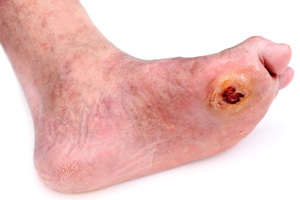DIABETES-related amputations have increased by 30% in the past decade with one Australian losing a limb every 3 hours, prompting calls to urgently improve care of diabetes-related foot disease in Australia.
In an editorial in this week’s MJA, diabetes experts said 8% of all diabetes-related deaths were attributable to foot disease. (1)
“These statistics are especially disappointing given the exponential growth in knowledge, research and published guidelines on managing diabetes-related foot disease (DRFD)”, the authors wrote.
Editorial coauthor Associate Professor Paul Wraight, a Melbourne endocrinologist and chair of the Australian Diabetes Foot Network, told MJA InSight he suspected the proportion of diabetes-related amputations was probably higher than 30%, but without national data it was not possible to know.
“At the moment in Australia, there is no national strategy to deal with diabetes-related foot disease”, he said.
“Even though we know the gold standard of treatment is management by multidisciplinary teams, the Australian health system does not fund this approach.”
Professor Wraight said some individual hospitals had “gone the extra yards” and established such teams, but it was not a model that had been taken up nationally.
In the MJA editorial, the authors called for the immediate implementation of six measures to improve care of DRFD, including national data collection on DRFD; improved access to subsidised care for people with diabetes who have a current or past foot complication; a national model for interdisciplinary DRFD care; national accreditation of interdisciplinary foot clinics and staff; subsidies for evidence-based treatments for DRFD; and diabetes care initiatives for Aboriginal and Torres Strait Islander peoples.
The Australian Diabetes Foot Network (ADFN), a multidisciplinary group of health professionals with expertise in diabetes-related foot complications, was recently established to advocate for improved DRFD care, starting with the implementation of these six measures.
“Australia has not successfully implemented key best practice recommendations for prevention and management of DRFD”, the editorial said.
“The Australian Diabetes Society has therefore established the Australian Diabetes Foot Network to advocate for greater funding of key treatments, provide education and support for health professionals, develop clinical guidelines, and support research into DRFD”, they wrote.
While the authors acknowledged that the chronic disease management items in the Medicare Benefits Schedule were helpful, they argued that more funding was needed for follow up.
“This funding arrangement does not allow for more frequent follow-up for individuals with acute DRFD complications or needing intensive secondary prevention due to previous ulceration and/or amputation”, they said.
A lack of funding for treatments was also hindering the effective provision of care, the authors said.
“There is an expectation that health professionals will provide care according to best-practice guidelines, but often the health system does not support such efforts. Research supports the use of wound dressings, total contact casting, walking braces, medical-grade footwear and orthotics to prevent and manage DRFD complications, but funding inequity often prohibits their use”, they wrote.
“Policymakers must acknowledge essential treatment modalities for wound healing and amputation prevention and subsidise their supply.”
In the same issue of the MJA, members of the ADFN provided a clinical update on the management of diabetes-related foot ulceration (DRFU), which accounts for 10 000 hospital admissions annually.
They said appropriate assessment and management of DRFUs was essential to reduce the risk of amputation. (2)
Patients with foot ulceration should be managed by at least a doctor, podiatrist and/or wound-care nurse, they said.
Effective management required a “package” of treatments, including wound debridement, wound dressings, pressure off-loading, glycaemic control and, when indicated, treatment of infection and improvement of peripheral blood flow. Health professionals without the resources, time or clinical skills to appropriately manage these patients should refer them to others who do have the resources and skills.
“People with complex or non-healing DRFUs should be referred to a multidisciplinary foot care team comprising medical, surgical, nursing, podiatry and other allied health professionals with appropriate skills and knowledge, for immediate management”, they wrote.
– Nicole Mackee
1. MJA 2012; 197: 197-198
2. MJA 2012; 197: 226-229
Posted 20 August 2012

 more_vert
more_vert